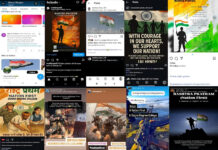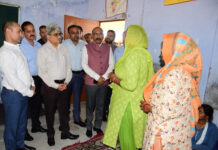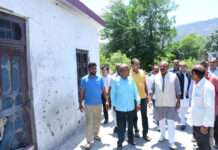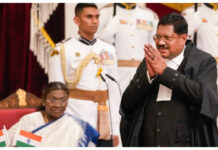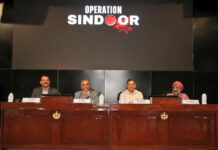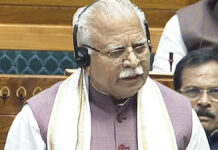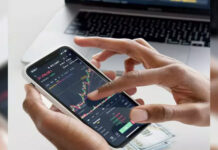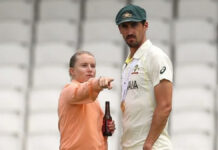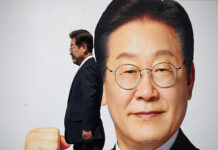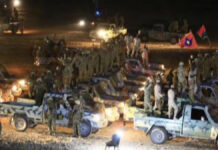
DOGRA HERALD BUREAU
THIRUVANANTHAPURAM, Nov 25
The “Diamond Jubilee’ of India’s first sounding rocket launch from Thumba in Kerala providentially coincides with the year 2023 which saw the historic twin feats of Chandrayaan-3 and Aditya-L1 missions, said the Union Minister of State for Space, Dr. Jitendra Singh today.
The year 2023 will also go down in history as the year when the Prime Minister Shri Narendra Modi declared 23rd of August, the day Chandrayaan-3 landed on the Moon, as ‘National Space Day’, he said.
Dr Jitendra Singh, who is also the Union Minister of State (Independent Charge) Science & Technology; MoS PMO, Personnel, Public Grievances, Pensions, and Atomic Energy, was addressing the Commemoration of the 60th year of the First Sounding Rocket Launch at a function at the Vikram Sarabhai Space Centre, Thumba Equatorial Rocket Launch Station (TERLS).
On the occasion, Dr Jitendra Singh witnessed the ceremonial launch of a similar Sounding Rocket undertaken from the Space pod where the original launch took place on November 21, 1963. In a symbolic gesture, the countdown was being announced by Shri Pramod P. Kale, who read out the countdown way back on the first launch 60 years ago.
Later, addressing the media, Dr Jitendra Singh said, the success of Chandrayaan-3 and Aditya-L1 missions reiterates India’s indigenous capabilities and vindicates the dream that Dr Vikram Sarabhai, the first Chairman of ISRO and the founding father of India’s Space Programme, saw six decades ago.
“It is also a vindication of the dream of Vikram Sarabhai, who might have been short of resources, but not short of confidence because he had faith in himself and in India’s inherent potential and inherent acumen,” said Dr Jitendra Singh.
Dr Jitendra Singh said, India uses Space Technology in various sectors like SVAMITVA, PM Gati Shakti, Infrastructure such as Railways, Highways & Smart Cities, Agriculture, Water Mapping, Telemedicine and Robotic Surgery, with an aim to bring about ‘Ease of Living’ for the common man.
Stating that India’s Space feats are a testimony to the ‘whole of science and the whole of nation’ approach, Dr Jitendra Singh thanked PM Modi for realising this dream to translate into reality “by opening up new vistas for India’s space sector and telling us that ‘Sky is not the Limit’.”
“India established its own regional navigation satellites system serving the strategic and civilian requirements in the last 9 years. PM Modi initiated Space sector reforms, making Space easily accessible for Indian private players and a comprehensive Indian Space Policy 2023 was released covering all stakeholders,” he said.
Dr Jitendra Singh said the country witnessed a StartUp boom only after the Space reforms were introduced with more than 150 Space Startups in a short span of time. The first Indian private sub-orbital launch was witnessed recently which was enabled through the Space sectoral reforms.
Building on the success of Indian Space initiatives which got a boost in the last 4 to 5 years, including the recent Chandrayan-3 and Aditya L1 Missions, Dr Jitendra Singh said, PM Modi has asked ISRO to aim for India’s first manned Space Mission ‘Gaganyaan’ by 2025, lunar sample return mission, ‘Bharatiya Antariksha Station’ (Indian Space Station) by 2035 and aim for the first Indian to set foot on the Moon by 2040.
Stating that India’s Space programme is now at an equal pace with the world’s leading Space agencies, Dr Jitendra Singh said the NASA might have been the first to land on the moon, but it was India’s Chandrayaan-1 that discovered water molecules on the Moon and now Chandrayaan-3 has for the first time landed on the South Pole of the moon.
“Even though the USA and the then Soviet Union had started their Space journey long before us and America also landed a human being on the surface of Moon in 1969, it was nevertheless our Chandrayaan that brought home the evidence of water on the surface of Moon,” he said, adding that the NASA has offered a Joint Space Mission to the International Space Station during the historic visit to PM Modi to the United States this year.
Dr Jitendra Singh said India’s space missions are designed to be cost effective, building upon human resources and skills.
“The Russian moon mission, that was unsuccessful, cost Rs.16,000 crore, and our (Chandrayaan-3) mission cost just around Rs.600 crore,” he said.
Dr Jitendra Singh said, the last ten years have been a watershed period in the scientific transformation in India’s journey since Independence. And as far as Space & Geospace and the entire ecosystem is concerned, it is even more visible, more so in the last five years.
“Till the year 2013, 40 launch vehicle missions were accomplished with nearly 3 launches on an average per year. This has doubled in the last decade with 53 launch vehicle missions at an average of 6 launches per year,” he said, adding, “ISRO had launched 35 foreign satellites till 2013. This has seen exponential growth in the last 9-10 years with the ISRO launching more than 380 foreign satellites, earning more than 220 Million Euros and over 170 Million US Dollars by launching American satellites.”
Referring to Amritkaal and Prime Minister’s vision for “India@2047”, Dr Jitendra Singh said, the value addition to India’s economy is going to come from hitherto unexplored sectors including the Space sector. From that point of view, he said, the Space economy is going to make a significant contribution to the nation’s economy when Independent India celebrates its 100th Independence Day and will be a frontline nation of the world.
“Due to opening up of the Space sector, emergence of Space Startups and Industry linkages, India’s Space economy could skyrocket from about $8 billion at present to $100 Billion in the years to come, as projected by foreign trade experts who are amazed by India’s quantum leap,” he said.

